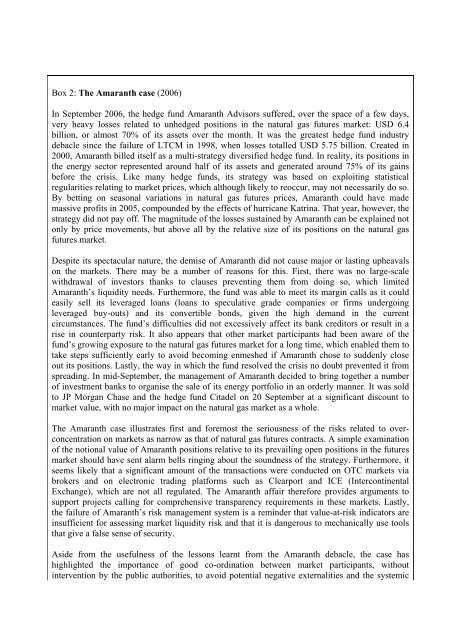Executive summary - Udo Bullmann
Executive summary - Udo Bullmann
Executive summary - Udo Bullmann
- No tags were found...
Create successful ePaper yourself
Turn your PDF publications into a flip-book with our unique Google optimized e-Paper software.
Box 2: The Amaranth case (2006)In September 2006, the hedge fund Amaranth Advisors suffered, over the space of a few days,very heavy losses related to unhedged positions in the natural gas futures market: USD 6.4billion, or almost 70% of its assets over the month. It was the greatest hedge fund industrydebacle since the failure of LTCM in 1998, when losses totalled USD 5.75 billion. Created in2000, Amaranth billed itself as a multi-strategy diversified hedge fund. In reality, its positions inthe energy sector represented around half of its assets and generated around 75% of its gainsbefore the crisis. Like many hedge funds, its strategy was based on exploiting statisticalregularities relating to market prices, which although likely to reoccur, may not necessarily do so.By betting on seasonal variations in natural gas futures prices, Amaranth could have mademassive profits in 2005, compounded by the effects of hurricane Katrina. That year, however, thestrategy did not pay off. The magnitude of the losses sustained by Amaranth can be explained notonly by price movements, but above all by the relative size of its positions on the natural gasfutures market.Despite its spectacular nature, the demise of Amaranth did not cause major or lasting upheavalson the markets. There may be a number of reasons for this. First, there was no large-scalewithdrawal of investors thanks to clauses preventing them from doing so, which limitedAmaranth’s liquidity needs. Furthermore, the fund was able to meet its margin calls as it couldeasily sell its leveraged loans (loans to speculative grade companies or firms undergoingleveraged buy-outs) and its convertible bonds, given the high demand in the currentcircumstances. The fund’s difficulties did not excessively affect its bank creditors or result in arise in counterparty risk. It also appears that other market participants had been aware of thefund’s growing exposure to the natural gas futures market for a long time, which enabled them totake steps sufficiently early to avoid becoming enmeshed if Amaranth chose to suddenly closeout its positions. Lastly, the way in which the fund resolved the crisis no doubt prevented it fromspreading. In mid-September, the management of Amaranth decided to bring together a numberof investment banks to organise the sale of its energy portfolio in an orderly manner. It was soldto JP Morgan Chase and the hedge fund Citadel on 20 September at a significant discount tomarket value, with no major impact on the natural gas market as a whole.The Amaranth case illustrates first and foremost the seriousness of the risks related to overconcentrationon markets as narrow as that of natural gas futures contracts. A simple examinationof the notional value of Amaranth positions relative to its prevailing open positions in the futuresmarket should have sent alarm bells ringing about the soundness of the strategy. Furthermore, itseems likely that a significant amount of the transactions were conducted on OTC markets viabrokers and on electronic trading platforms such as Clearport and ICE (IntercontinentalExchange), which are not all regulated. The Amaranth affair therefore provides arguments tosupport projects calling for comprehensive transparency requirements in these markets. Lastly,the failure of Amaranth’s risk management system is a reminder that value-at-risk indicators areinsufficient for assessing market liquidity risk and that it is dangerous to mechanically use toolsthat give a false sense of security.Aside from the usefulness of the lessons learnt from the Amaranth debacle, the case hashighlighted the importance of good co-ordination between market participants, withoutintervention by the public authorities, to avoid potential negative externalities and the systemic





